I have the following code:
from win32com.client import Dispatch
from tkinter import *
from tkinter import ttk
import tkinter
class applicazione:
def __init__(self, root):
self.root = root
self.root.title('Controllo dati per fatturazione elettronica - Manticle - Smith & Nephew Italia')
ttk.Frame(self.root, width=300, height=250).pack()
#### label list
self.titoli = list()
self.titoli_BFT = ["Num_Doc", "Cod_Art", "Unita Misura", "Tot_Prod", "Quant_Prod", "Perc_IVA_Prod", "Tot_IVA_Prod",
"Linea_Prod", "Sconto", "Perc_Sconto", "Tipo_Sconto", "Cod_Art2", "Desc_Art"]
self.titoli_HFT = ["Dest_Cod_FIS_P_Iva", "Cod_Cli", "Dest_RagSoc1", "Dest_RagSoc2",
"Dest_Indirizzo", "Dest_CAP", "Dest_Localita", "Dest_Provincia", "Cli_Cod_Fis_P_Iva",
"Cod_Dest", "Cli_RagSoc1", "Cli_RagSoc2", "Cli_Indirizzo", "Cli_CAP",
"Cli_Localita", "Cli_Provincia", "Tipo_Doc", "pre_Num_Doc", "Num_Doc",
"Data_Doc", "Vs_Rif", "Data_Rif", "Blank", "Blank2", "CPT", "Scad_Pagamento",
"Descr", "Num_Ord", "Tot_Imp", "Tot_IVA", "Tot_Doc", "Nazione", "IPA", "Reg_Fiscale"]
self.titoli_IVA = ["Num_Doc_TMP", "Num_Doc", "Imponibile", "IVA, Tot", "Perc_IVA"]
self.titoli_RIF_DOC = [ "Num_Doc_TMP", "Num_Doc", "Rif_Doc" ]
self.titoli_RIF_DOC_BFT = ["Num_Doc_TMP", "Num_Doc", "Cod_Art", "NOTE" ]
self.titoli_anomalieBFT = ["ordine", "anomalia"]
self.titoli_anomalieHFT = ["ordine", "anomalia"]
self.inizializza_widgets()
self.lettura()
def inizializza_widgets(self):
#label
self.lblins=tkinter.Label(self.root, text="Controllo dati per fatturazione elettronica", font=("Helvetica", 12))
self.lblins.place(x=10, y=10
for i in range (0,len(self.titoli_HFT)):
j = 80*i
self.lblnome=tkinter.Label(self.root, text= self.titoli_HFT[i], font=("Helvetica", 8))
self.lblnome.place(x=85+j, y=50)
#buttons
ttk.Button(self.root, , text='Inserisci', width='10').place(x=645, y=590)
#pulsante lettura
ttk.Button(self.root, text='Modifica', width='10').place(x=725, y=590)
ttk.Button(self.root, text='Indietro', width='10').place(x=805, y=590)
ttk.Button(self.root, text='Avanti', width='10').place(x=885, y=590)
def onFrameConfigure(self, event):
'''Reset the scroll region to encompass the inner frame'''
self.canvas.configure(scrollregion=self.canvas.bbox("all"))
def lettura(self):
xl= Dispatch("Excel.Application")
xl.Visible = True
self.checkb_intvar = list() #contiene una lista di 1 o 0 associati alle checkbox nella lista quadratini
self.quadratiniB = l = [None] * (13 * len(self.titoli_BFT) )
self.quadratiniH = l = [None] * (13 * len(self.titoli_HFT) )
wbH = xl.Workbooks.Open(r'C:\Users\\Marco\\LAVORO\\Smith&Nephew\\appRonca\\fonte\\HFT_SAP_2.csv')
print("wbH")
wsH=wbH.WorkSheets(1) # get a reference to the first sheet
cont = 0
MAX = 3 #13 lunghezza visibile senza barra navigatrice del numero di righe nella finestra 13
cont = 0
for i in range(0, MAX):
for j in range(0,len(self.titoli_HFT)):
print("for for")
cont = cont + 1
print("i")
print(i)
print("j")
print(j)
print(" The {} set is often represented as {{0}} ".format("empty"))
#### indexes for DI excel cells management
k = 80*j #i con j
l = 40*i #k con l
contvalueX = i + 1 #con zero da errore allora +1
contvalueY = j + 1 #con zero da errore allora +1
self.txt1 = tkinter.Text(self.root, width='10', height='1')
#Reading excel cells file
if (wsH.Cells(contvalueX, contvalueY ).Value != None):
self.txt1.insert('1.0', wsH.Cells(contvalueX, contvalueY ).Value)#ws.Cells(1,i).Value
self.txt1.tag_add("start", "1.0", "1.13")
if (contvalueY == 1 ):
self.txt1.tag_config("start", background="white", foreground="red")
#self.txt1.tag_configure("red", foreground="red")
#self.txt1.highlight_pattern("word", "red")
#self.txt1 = tkinter.Text(self.root, width='10', height='1', text = ws.Cells(1,i).Value)
self.txt1.place(x=85+k, y=80+l) #5 + 80
print("if")
else: #None case
print("else")
self.txt1.insert('1.0', "")
self.txt1.place(x=85+k, y=80+l)
if (contvalueY == 1 ):
self.txt1.tag_config("start", background="white", foreground="red")
wbH.Close()
xl.Quit()
if __name__ == '__main__':
root = tkinter.Tk()
w, h = root.winfo_screenwidth(), root.winfo_screenheight()
root.geometry("%dx%d+0+0" % (w, h))
applicazione(root)
root.mainloop()
The application runned:

I read data from an excel file (lettura function) but i would like to add an horizontal and a vertical scrollbar i read first of all this:
Adding a scrollbar to a group of widgets in Tkinter
but use "grid" that i do not use and i'm not able to associate my double "for" "Text" to the vertical scroll bar (Lettura function)
The following code is edited with the scrollbar but does not work:
import tkinter as tk
from win32com.client import Dispatch
from tkinter import *
#from tkinter import ttk
import tkinter
class Example(tk.Frame):
def __init__(self, root):
tk.Frame.__init__(self, root)
root.title('Controllo dati per fatturazione elettronica - Manticle - Smith & Nephew Italia')
#tk.Frame(root, width=100, height=450).pack()
self.canvas = tk.Canvas(root, borderwidth=0, background="#C0C0C0")
self.frame = tk.Frame(self.canvas, background="#ffffff")
self.vsb = tk.Scrollbar(root, orient="vertical", command=self.canvas.yview)
self.canvas.configure(yscrollcommand=self.vsb.set)
self.vsb.pack(side="right", fill="y")
self.canvas.pack(side="left", fill="both", expand=True)
self.canvas.create_window((4,4), window=self.frame, anchor="nw",
tags="self.frame")
self.frame.bind("<Configure>", self.onFrameConfigure)
self.titoli_BFT = ["Num_Doc", "Cod_Art", "Unita Misura", "Tot_Prod", "Quant_Prod", "Perc_IVA_Prod", "Tot_IVA_Prod",
"Linea_Prod", "Sconto", "Perc_Sconto", "Tipo_Sconto", "Cod_Art2", "Desc_Art"]
self.titoli_HFT = ["Dest_Cod_FIS_P_Iva", "Cod_Cli", "Dest_RagSoc1", "Dest_RagSoc2",
"Dest_Indirizzo", "Dest_CAP", "Dest_Localita", "Dest_Provincia", "Cli_Cod_Fis_P_Iva",
"Cod_Dest", "Cli_RagSoc1", "Cli_RagSoc2", "Cli_Indirizzo", "Cli_CAP",
"Cli_Localita", "Cli_Provincia", "Tipo_Doc", "pre_Num_Doc", "Num_Doc",
"Data_Doc", "Vs_Rif", "Data_Rif", "Blank", "Blank2", "CPT", "Scad_Pagamento",
"Descr", "Num_Ord", "Tot_Imp", "Tot_IVA", "Tot_Doc", "Nazione", "IPA", "Reg_Fiscale"]
#self.inizializza_widgets()
self.populate()
self.lettura()
def inizializza_widgets(self):
#label title
self.lblins=tk.Label(root, text="Controllo dati per fatturazione elettronica", font=("Helvetica", 12))
self.lblins.place(x=10, y=10)
for i in range (0,len(self.titoli_HFT)):
j = 80*i
self.lblnome=tk.Label(root, text= self.titoli_HFT[i], font=("Helvetica", 8))
self.lblnome.place(x=85+j, y=50)
#965 560
tk.Button(root, text='Inserisci', width='10').place(x=645, y=590)
#pulsante lettura
tk.Button(root, text='Modifica', width='10').place(x=725, y=590)
tk.Button(root, text='Indietro', width='10').place(x=805, y=590)
tk.Button(root, text='Avanti', width='10').place(x=885, y=590)
def lettura(self):
xl= Dispatch("Excel.Application")
xl.Visible = True
wbH = xl.Workbooks.Open(r'C:\Users\\Marco\\LAVORO\\Smith&Nephew\\appRonca\\fonte\\HFT_SAP_2.csv')
print("wbH")
wsH=wbH.WorkSheets(1) # get a reference to the first sheet
cont = 0
MAX = 9 #13 lunghezza visibile senza barra navigatrice del numero di righe nella finestra 13
cont = 0
for i in range(0, MAX):
for j in range(0,len(self.titoli_HFT)):
print("for for")
cont = cont + 1
print("cont")
print(cont)
#### INDEXES
k = 80*j #i con j
l = 40*i #k con l
contvalueX = i + 1 #con zero da errore allora +1
contvalueY = j + 1 #con zero da errore allora +1
self.txt1 = tk.Text(root, width='10', height='1')
#Lettura celle del file HFT
if (wsH.Cells(contvalueX, contvalueY ).Value != None):
self.txt1.insert('1.0', wsH.Cells(contvalueX, contvalueY ).Value)#ws.Cells(1,i).Value
self.txt1.tag_add("start", "1.0", "1.13")
if (contvalueY == 1 ):
self.txt1.tag_config("start", background="white", foreground="red")
self.txt1.place(x=85+k, y=80+l) #5 + 80
print("if")
else: #None case
print("else")
self.txt1.insert('1.0', "")
self.txt1.place(x=85+k, y=80+l)
if (contvalueY == 1 ): #### qui si richiama la funziona regole con tutte le regole
self.txt1.tag_config("start", background="white", foreground="red")
wbH.Close()
xl.Quit()
def onFrameConfigure(self, event):
'''Reset the scroll region to encompass the inner frame'''
self.canvas.configure(scrollregion=self.canvas.bbox("all"))
if __name__ == "__main__":
root=tk.Tk()
Example(root).pack(side="top", fill="both", expand=True)
root.mainloop()
and this: How to add a scrollbar to a window with tkinter? that is not organise like a class.
how can i implement the 2 scrollbars?
UPDATE
new version:
from win32com.client import Dispatch
from tkinter import *
from tkinter import ttk
import tkinter
class applicazione:
def __init__(self, root):
self.root = root
# Top-level frame
self.frame = ttk.Frame(self.root, relief="sunken")
# Canvas creation with double scrollbar
hscrollbar = ttk.Scrollbar(self.frame, orient = tkinter.HORIZONTAL)
vscrollbar = ttk.Scrollbar(self.frame, orient = tkinter.VERTICAL)
self.canvas = tkinter.Canvas(self.frame, bd=0, highlightthickness=0, yscrollcommand = vscrollbar.set, xscrollcommand = hscrollbar.set)
vscrollbar.config(command = self.canvas.yview)
hscrollbar.config(command = self.canvas.xview)
# Add controls here
self.subframe = ttk.Frame(self.canvas)
#Packing everything
self.subframe.pack(padx = 15, pady = 15, fill = tkinter.BOTH, expand = tkinter.TRUE)
hscrollbar.pack( fill=tkinter.X, side=tkinter.BOTTOM, expand=tkinter.FALSE)
vscrollbar.pack( fill=tkinter.Y, side=tkinter.RIGHT, expand=tkinter.FALSE)
self.canvas.pack(side = tkinter.LEFT, padx = 5, pady = 5, fill = tkinter.BOTH, expand= tkinter.TRUE)
self.frame.pack( padx = 5, pady = 5, expand = True, fill = tkinter.BOTH)
self.canvas.create_window(0,0, window = self.subframe)
self.root.update_idletasks() # update geometry
self.canvas.config(scrollregion = self.canvas.bbox("all"))
self.canvas.xview_moveto(0)
self.canvas.yview_moveto(0)
self.root.title('Controllo dati per fatturazione elettronica - Manticle - Smith & Nephew Italia')
ttk.Frame(self.root, width=300, height=250).pack()
#### Titles
self.titoli_HFT = ["Dest_Cod_FIS_P_Iva", "Cod_Cli", "Dest_RagSoc1", "Dest_RagSoc2",
"Dest_Indirizzo", "Dest_CAP", "Dest_Localita", "Dest_Provincia", "Cli_Cod_Fis_P_Iva",
"Cod_Dest", "Cli_RagSoc1", "Cli_RagSoc2", "Cli_Indirizzo", "Cli_CAP",
"Cli_Localita", "Cli_Provincia", "Tipo_Doc", "pre_Num_Doc", "Num_Doc",
"Data_Doc", "Vs_Rif", "Data_Rif", "Blank", "Blank2", "CPT", "Scad_Pagamento",
"Descr", "Num_Ord", "Tot_Imp", "Tot_IVA", "Tot_Doc", "Nazione", "IPA", "Reg_Fiscale"]
self.inizializza_widgets()
def inizializza_widgets(self):
self.lblins=tkinter.Label(self.root, text="Controllo dati per fatturazione elettronica", font=("Helvetica", 12))
self.lblins.place(x=10, y=10)
for i in range (0,len(self.titoli_HFT)):
j = 80*i
self.lblnome=tkinter.Label(self.root, text= self.titoli_HFT[i], font=("Helvetica", 8))
self.lblnome.place(x=85+j, y=50)
ttk.Button(self.root, text='Inserisci', width='10').place(x=645, y=590)
ttk.Button(self.root, text='Modifica', width='10').place(x=725, y=590)
ttk.Button(self.root, text='Indietro', width='10').place(x=805, y=590)
ttk.Button(self.root, text='Avanti', width='10').place(x=885, y=590)
if __name__ == '__main__':
root = tkinter.Tk()
root.title( "Double scrollbar with tkinter" )
w, h = root.winfo_screenwidth(), root.winfo_screenheight()
root.geometry("%dx%d+0+0" % (w, h))
applicazione(root)
root.mainloop()


